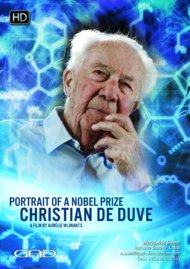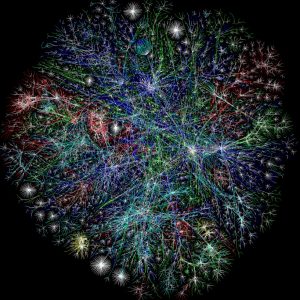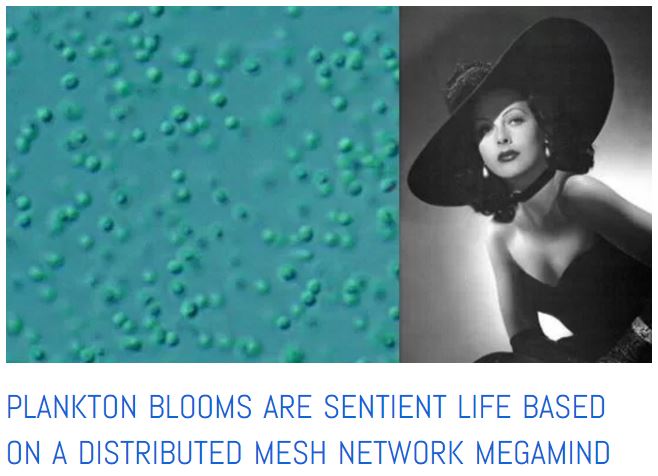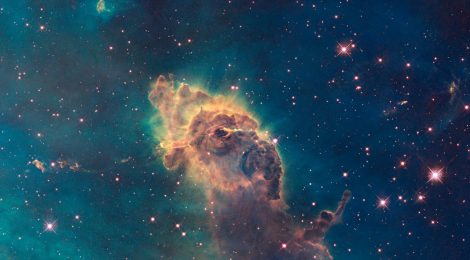
Vital Dust
There may be more to dust than meets the eye, it’s ecology is remarkable.
If you liked Charles Darwin’s Origin of the Species you might love Nobel Laureate Christian de Duve’s masterpiece about the origin of all life not just some of its earthly species.
The answer to the question of life, the universe, and everything is that it is all an inevitable result of universal chemistry.
Vital dust is even more vital when the size of the motes is tiny.
Christian de Duve, now passed, wrote in his 1995 book Vital Dust not about mere motes of dust, he tackles fundamental chemistry and how it leads inevitably to life, consciousness, environmentalism and philosophy. His writing style is what you might expect from a Belgian Nobel laureate in medicine physiology who was second to none in his scientific understanding of the biochemistry of life.
His 1974 Nobel Prize was for his elucidation of the most vital inner workings of cells. ‘Vital Dust’ is filled with technical chemical science lingo that he notes ‘does not have difficult equations’, he doesn’t hold back however one wit on the deep technical language he employs and one is immediately struck with the presence of his genius and mastery of his field.
Christian de Duve writes from the point of view of a lifetime of exploration and one who knows perhaps better than anyone about the clouds of carbon rich dust, which pervades our universe. In the book he notes life, aka you and I and all other carbon based lifeforms, is no accident. It was and is bound to always arise as that is the simple certainty dictated by chemistry. Life will always and everywhere appear in the very molecular forms that are not very different from its forms on Earth, wherever physical conditions are similar to those that prevailed on our planet from some four or five billion years ago to the present.
“The conclusion seems to me almost inescapable. Those who claim that life is a highly improbable event, possibly unique, have not looked closely enough at the chemical realities underlying the origin of life. Life is either a reproducible, almost common-place manifestation of matter, given certain conditions, or a miracle. Too many steps are involved to allow for something in between.”
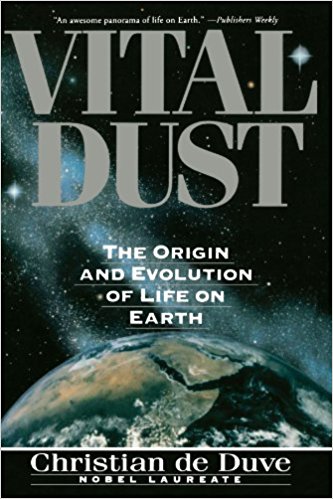
Vital Dust
His conclusion is that life, indeed intelligent life, is inescapable chemistry and it is neither a God given creation nor an accident but rather it is an integral part of the structure and working of the universe. Life and the universe has meaning because of this and the philosophy elucidated is positive and hopeful.
Ecology of dust, and atoms
De Duve’s ideas immediately reveal more than one vital dusty path. While my focus on this post is more about the biological paths de Duve and I share an interest in, there is very different path, the atom-ecology path of dust and its relationship with hydrogen. Therein lies another entirely story of how vital dust is to this universe and how the cosmogenesis of the very elements and isotopes of the periodic table have come into their incredible atomic diversity.
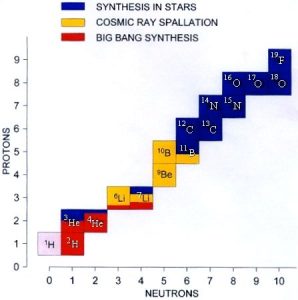
Just one path, the conventional path, to the synthesis of the elements. It’s origin was lacking in the understanding of vital dust. click to enlarge
Had de Duve looked one step deeper past the chemical bonds and bounds that were his forte he would have seen what I see, that universal ‘chemistry’ reaches deep into the nuclei of atoms and there it provides for inevitable mechanisms that are also going on constantly, albeit within extraordinary ecologies.
The interaction of vital dust and hydrogen deep within atom-ecology, perhaps better referred to as ‘sub-atomic ecology’, is a mystery that is just now beginning to be revealed. That’s the major focus of this blog and you might find plenty to read here along this dusty path.
The microcosm of life is where dust is in one of its most vital roles.
For all of the time that life has existed on this Earth the vast majority of life has been in microscopic forms. Even within the megaforms of life that exist today, ourselves included, large life is really just a cooperative collection of microscopic life. De Duve’s point of view derives from his life studying the inner ecology, the micro-ecology of life and he shares some incredible insights about the origin and evolution of life from inanimate chemical molecules, his vital dust, as that dust transformed itself into what we think of today as our own higher life form. For De Duve the process of chemistry/life is never-ending combinatorial chemistry that simply takes place always and forever. We were, are, and will be all born of this universal chemistry.
If you equate the appearance of a
single bacterial cell to chance
assembly of its atoms
eternity will not suffice
to produce even one.
From the enormous sum
of ‘lucky draws’ behind the
success of the evolutionary game
one may wonder to legitimate extent
this success is actually written
into the fabric of the universe.
Christian de Duve
The book begins by explaining the chemistry of the earliest forms of life from the beginning in is most dust like forms. Then like Darwin he delves into evolution and as multi-cellular organisms appear he explains how and why they take charge of the planet and change it to their liking. They first introduce Green to the world via photosynthesis which floods the world with oxygen which is deadly poison. As such the fittest survive the oxygen chaos and in doing so move out of the unicellular seas onto land.
Eventually he delves into how intelligence as we know and practice it arrived and how it too is an inevitable consequence of universal chemistry. He speculates about where intelligent life may go in the few billions of years left before our planet is devoured by our sun. That it will continue is certain as will intelligence, both life and intelligence are a cosmic imperative.
.
In de Duve’s personal philosophy about the meaning of life he explains.
“For me, meaning is to be found in the structure of the universe, which happens to be such as to produce thought by way of life and mind. Thought, in turn, is a faculty where by the universe can reflect upon itself, discover its own structure, and apprehend such immanent entities as truth, beauty, goodness and love. Such is the meaning of the universe, as I see it.”
All life today is at an equally highly evolved state
The great Belgian chemist understood that all of life as we see it today arrived here in this present time through constant parallel evolution. There are no ‘lower’ lessor evolved life forms today, we have all taken the very same journey through time to the present. This has profound implications on how we view intelligent or sentient life.
For me one thing de Duve does not expound sufficiently upon are some of the mysteries of life in the blue part of this blue planet where still today 99.99% of all life lives as microscopic entities, some even sentient microbial collectives. De Duve makes certain to allowing for plenty of new discovery when he defers to the unknowns of quantum physics and the alternative it offers to linear one dimensional explanations of how the mind is different from the brain.
Mind vs. Brain
Regarding the mind, the thinking intelligent brain vs. the unthinking brain, he points out that the thickening of the cortex of the brain in hominids, aka our ancestors, led to development of our ‘mind’ and intelligence along with the faculty for speech. The evidence he points out being that such thicker conductive sheeting, aka cortex, provides for more complex thought which makes fine sense in a linear one dimensional context, in a quantum multi-dimensional context such layers become mind-blowingly become potent.
De Duve, ever the Jesuit educated schoolboy, seems to have forgotten that elephants, you know the animals that never forget, have the thickest of all cortex layers. Of recent it has also been discovered that elephants have complex communication and talk and sing to each other in ultra-low infrasound frequencies below that which we humans can hear. That’s an ideal frequency to use when you are trying to communicate through miles of sound deadening forest. Then again there exist some very much different equally evolved life forms who also choose the advantage of thicker rather than thinner conductive layer. It seems the very thick mycelia based layers through which communication is observed in plants and bacterial mats would fit de Duce’s thick is better notion for the mind.
He perhaps needn’t peer back into the oceans as he so very clearly describes his view that life today is ALL equally evolved, hence there are no primitive life forms present today they and we have grown side by side over the eons of time. Since he clearly shows that higher life is for all intents and purposes collections of microscopic life, the question of intelligence, aka sentience, which he considers is destined to arrive at an evolutionary point in time, aka the present, intelligence can hardly be considered to be unique to just one or even a few forms of life. Intelligent life is in countless forms everywhere, and it is unremarkable that this is so.
His answer to the obligatory question, ‘if intelligent life is everywhere in the universe, where is everybody’ he points out the absurdity of this question which somehow neglects the vast distances of space and time that separate the stars, there simply hasn’t been time for Earthlings to be in communication with any other intelligent life yet.

THE WHOLE TREE OR SHOULD WE SAY SHRUB OF LIFE – SENTIENT LIFE IS FOUND ALL ALONG THE ARC OF TIME CLICK TO ENLARGE
I would have loved to have discovered de Duve before he passed as I would have made every effort to go and talk with him about vital dust. My view of ‘vital dust’ is along different paths than his in that on one path I am focused on the role of rather ordinary mineral dust that blows in the wind and how it is the key sustaining element for the vast majority of life on our blue planet. On my other path I have been intrigued by my experiments into the role of the tiniest of dust motes interacting with isotopes of hydrogen and the utterly amazing nucleosynthesis that takes place as a result.
We might have enjoyed musing about the different ‘vitals’ of dust. In his book he elegantly describes the incredibly important and vital role of iron rich mineral dust in delivering a vital quantum boost to the evolution of life from the early probiotic stage on the course to our present day diversely evolved and universally vital and intelligent life stage. Today iron rich dust remains all important to life on this blue planet. You can read all about my life with bits of dust in the oceans at www.russgeorge.net.
Everywhere on this blog you will find plenty of the footprints and stepping stones into the frontier world of atom-ecology.
